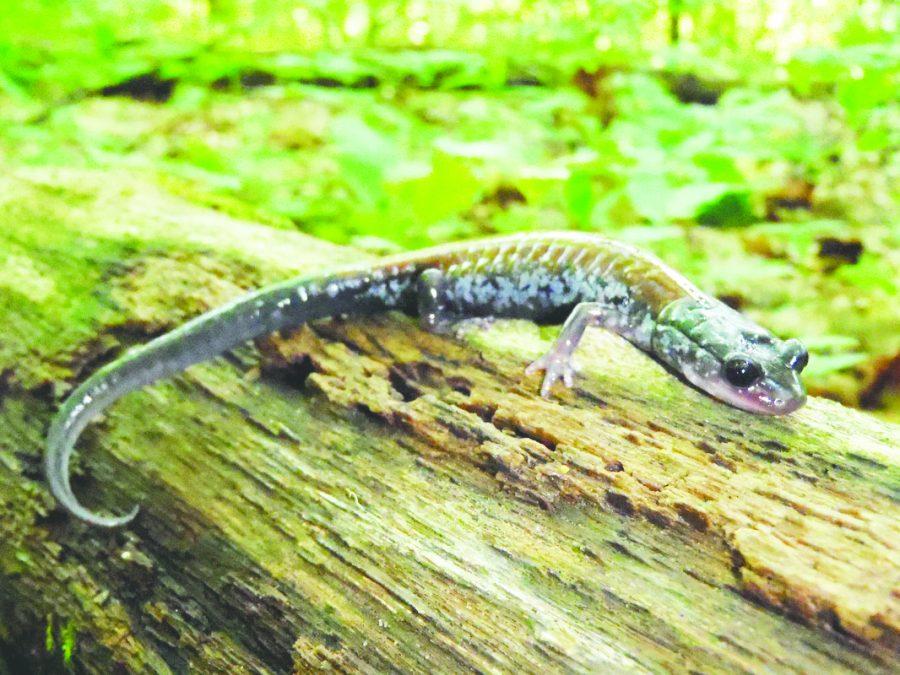 When Nicholas Caruso, a graduate student in the biological science department, dissects a salamander, he cannot find its lungs. That is disconcerting, but it’s actually not terribly surprising – they are, after all, lungless salamanders.
When Nicholas Caruso, a graduate student in the biological science department, dissects a salamander, he cannot find its lungs. That is disconcerting, but it’s actually not terribly surprising – they are, after all, lungless salamanders.
What Caruso has also noticed, researched and published is that salamanders are getting smaller.
“There used to be much more bigger salamanders. For these guys, bigger is better,” he said. “We’re just not seeing big salamanders anymore.”
Caruso is lead author on “Widespread rapid reductions in body size of adult salamanders in response to climate change,” which was published in March in science journal Global Change Biology and recieved extended media coverage.
“Having this paper with my name on the front is great,” he said. “The press that it’s receiving is probably even better.”
(See also “Professor receives award for success in geology research“)
Caruso works in the lab of Leslie Rissler, an associate professor and curator of herpetology. Rissler said Caruso’s doctoral research in her lab will be important work.
“Nick’s Ph.D. work in my lab will be focused on determining whether the body size changes are truly evolutionary,” Rissler said. “Publishing research is one of, if not the, most important jobs of a scientist, and to have such an extraordinarily high press article at his early stage is fantastic.”
Outlets like NBC, Nature, The Weather Channel and BBC Nature have picked up Caruso’s research and its implications.
“It just seemed to snowball,” Caruso said. “A few days ago, I found it mentioned on Buzzfeed.”
Caruso said he thinks the story’s popularity might be due in part to how adorable salamanders are and how catchy the idea of “shrinking salamanders” is, but he also knows climate change is a hot topic issue and said the findings of his research indicate something may be happening or has already happened in the natural world.
“Unfortunately, I think the consensus now is that if amphibians are responding, it might be too late,” he said. “They’re indicating something, but we probably should have done something about it beforehand.”
(See also “History of education conference presents speakers, research“)
The salamanders Caruso studied have thinner skin and respond more quickly to environmental changes, but they also have growth rings in their femurs. That’s the next step for Caruso, investigating whether the salamanders are smaller because they are dying younger or because they are not putting as much energy into growing.
“Hopefully, that will get at, ‘Is this a mortality issue or a growth issue?’” he said. “And then genetics [of it] is a whole other can of worms.”
Rissler said one of the paper’s unknowns is whether the change is due to true evolution or plasticity, the ability of species to adapt. But, she said, it does show that salamanders are smaller now than they were a few decades ago.
“We can see this because specimens from natural history collections – museums – of the same species from the exact same geographic regions exist,” Rissler said.
In fact, Caruso travelled to see an extensive collection of salamanders at the Smithsonian Institution’s Museum Service Center.
In addition to the Smithsonian, Caruso gives credit to members of the Smithsonian Institute and the paper’s three co-authors: Dean Adams of Iowa State University; Karen Lips of the University of Maryland; and Michael Sears of Clemson University.
Caruso said he also thanks the field assistants who joined him in collecting current data, camping and traveling in his truck through Appalachia, where they encountered rain and hail.
“All that good stuff – all just running around, measuring salamanders,” Caruso said. “All of those people are pretty awesome.”
What he saw there may have seemed normal to him, but as he suspected, it actually reflected a noticeable change – something that didn’t escape the attention of 2 biologist he met with early on at the Smithsonian, who didn’t yet know the subject of Caruso’s research before asking him about salamanders.
“He was like, ‘You know, when I’ve been going out, I just haven’t been seeing big salamanders anymore. Do you think there’s something to that?’” Caruso said. “I just started laughing.”
(See also “The Way of our Water“)









